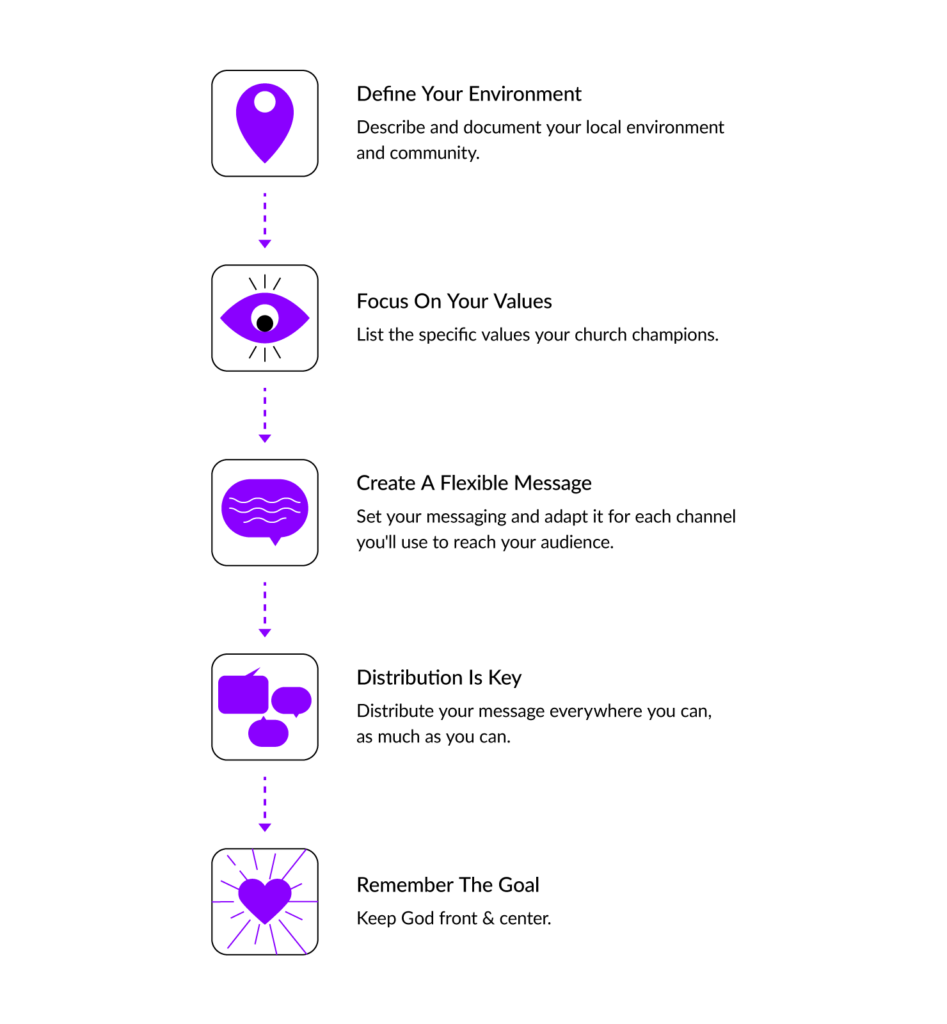I would not be serving my local community today if it weren’t for a dedicated church communication strategy, and more than likely, neither would you. Communication is the very lifeblood of society and humanity as a whole. Without it, meaning and the sharing of information is impossible.
As such, communication is a major key to sharing the gospel of Jesus. If we do not and cannot actively communicate, there is no way to share the Good News like Jesus did (Luke 8:1). Unfortunately, building a comprehensive and efficient church communication strategy is easier said than done.
Here are the topics that we are tackling to help you with this:
- What Is A Church Communication Strategy?
- How To Develop A Church Communications Strategy
- Internal Church Communication Strategy
- External Church Communication Strategy
What Is A Church Communication Strategy?
A church communication strategy is the means by which you express the gospel to those around you. There are many forms and steps that it takes, and these can differ for each church. This strategy requires careful planning and mindfulness for those who a church is trying to reach.
At its core, church communication strategy is the method of growing and building your community of believers. Communication is the foundational way that we as humans connect, and strategically picking how we do so can spiritually expand the four walls of the church.
It does not happen by accident but necessitates the heartfelt, prayerful intention of the church’s leaders and congregation. In my time in full-time ministry, I see church communication as one of the most crucial parts of sharing God’s message to the world.
Church Communication Plans
Developing a physical, tangible plan for how you communicate is highly recommended. Though some churches are able to grow without the need for schedules, spreadsheets, or dozens of pages of documents, others will benefit from the structure that it provides.
Having a clear picture and idea of what you are trying to communicate, and how you will do it, can prepare your leadership in a great way. This gives a common goal that is easy to grasp and you will more clearly understand the results, too. That is why we previously created a dedicated guide just for making church communication plans.
If you want in-depth insight into how to form a plan of action across multiple forms of communication, including helpful church comms templates, that guide is for you.
How To Develop A Church Communications Strategy?

When it comes to your overall church communication strategy, there are several steps that you should follow. These steps will guide you along the way to finding out what works best for your church. Every community is different, but these steps are a guideline by which you can successfully build your church.
1. Define Your Environment
To start out on the right foot, you need to first look around at your environment. This includes not just the church and its building(s), but the area around it as well. The ultimate goal for us as Christians is to spread the gospel to the entire world, but we cannot just jump straight to that step.
We, first, need to build up to that and it begins with the immediate area around us. The city, county, region, state, and province that we are in is our environment. Start small and clearly define what is happening in your area. Why this is important is because your church’s environment on one side of the world will be completely different than someone else’s on the other side of the world.
There can even be dramatically different situations between churches in the same state, let alone country. It is crucial that you understand the types of people that you are trying to communicate the message of salvation to.
For instance, one church might find that they need to help the large number of single parents and broken homes in their area, while another in a different area notices the significant population of starving children. And yet, still, there might be another church that needs to tackle both groups.
In my experience, our organization initially saw the immediate needs of those in a small neighborhood known as Echo Park, then gradually expanded to involve places like Skid Row, the entirety of LA County, and eventually other nearby places like Long Beach.
Once you define the environment and the needs around you, you can then start to meet those needs and communicate properly. It is imperative that you know the people that live around you every day.
2. Focus On Your Values
Once you know who you are communicating with, it is then important to decide what you will be saying to them. This is where your values come into play. The Bible is universal and necessary for every church, but there are some parts that will be helpful with the situations in your community.
You need to determine the values that your church has, so that you can be transparent in your messages to the community around you. This means creating the fundamentals by which your church stands. What do you believe in? What sort of events do you have each week? What are the goals you have in mind?
These answers may be obvious to you, but it is not necessarily the case for someone unfamiliar with your church. You should be ready to communicate these values clearly so that even the newest believer has an idea of what they are getting involved with.
3. Craft A Flexible Message
With your audience and values in mind, it is time to create your means of communication and messaging. This can be the make it or break it point for some churches in forming their church communication strategy. Above all else, it is imperative that you craft flexible messaging for use everywhere.
The Bible is the versatile form of God’s Word that was created for all people of all ages of all generations. Just as it remains a flexible communication from God, so should the church’s strategy. The values that you have are not meant for a single form of media or one person; it should be malleable to the point of including anyone and everyone at any time.
What this means in practice is that you should be communicating across multiple fields and forms. With these same values in mind, you should execute them in a way that will make sense for the traditional face-to-face meetings with people in your community as well as online in the modern digital age.
Though the words and method may change considerably, the meaning should never. This way, no matter how someone finds out about your church, they will have the same knowledge of it as everyone else.
4. Distribution Is Key
With the modern style of communication, it is vastly different from even at the time of Jesus. This is where your distribution must be flexible as well. Churches should communicate with prospective and current members through a variety of ways. This ensures that everyone gets the message and in the right way for them.
Social media, for instance, is a huge part of modern church communication strategy. If your church does not already have a Facebook, Twitter, and Instagram, get on that. These are the bare minimum and I think that is even putting it too lightly.
These days, churches should also have a digital service available. Stream your services online on YouTube and elsewhere, or, at the very least, record it for later uploading as a video or bible podcast. Whether or not you personally agree with church members attending online from their home, this is a must these days for integrating new members and keeping old ones.
Finally on the topic of communication channels, there is TikTok. This is a rising social media app that I highly recommend to any church looking to grow. This is where the younger possible churchgoers will be and the church needs to be there, too, to meet their needs. Communicating your announcements, services, and events online in goofy short social media posts using trending sounds can set your church apart from everyone else.
Of course, you should not forget about the old-fashioned methods of communication as well. Going door-to-door for follow ups, passing out flyers, setting up posters, and all that can still be effective. I know this from personal experience. We dedicated entire days of the week at the LA Dream Center just to pass out flyers in our community.
5. Remember The Goal
Lastly, the final key to excellent church communication strategy is always remembering why you are running this race (Acts 20:24). In every little step that you take, always seek God and His assistance in the matter. Make sure that every part of your strategy aligns with him and that nothing is taken for granted.
With such busy lives and so many avenues for communication, it can be tough to keep up with everything. People can be lost in the process, due to neglect of the church and forgetting about what really matters. This is a common mistake that I’ve found these days.
If necessary, take steps back sometimes and look at the bigger picture. If it is too much for your team to handle, that means it is time to get more help or refocus. Never let the strategy, plans, and methods of saving souls cause you to lose sight of those people.
No matter how big or small your church is, always remember why we are doing this. In my department, we ran programs dealing with over 2000 kids a week in the Los Angeles area. It is a lot to manage and it took a lot of people to make it happen. Sometimes it was a struggle and we made mistakes but we always tried to do the small things.
These include visiting someone’s home to see how they’re doing, bringing cookies or treats just to let someone know you’re thinking of them, sending out personal text messages to first-time guests, and so on. Try not to focus so much on the strategy that you forget the goal.
Internal Church Communication Strategy
A key part about church communication strategy is knowing the differences and similarities between internal and external. Ultimately, they should be one and the same, but there are parts that are unique to each. The internal strategy constitutes your plan when it comes to communicating with the already present congregation.
In this, I think that transparency is absolutely crucial. If we cannot be clear with our church staff and members as communicators, this can lead to distrust. That, in turn, can lead to discourse and the divorce of a church with itself. Even with the difficult topics and scenarios, it is imperative that the church leaders come together and decide a way to communicate what happened with the body.
It is also important for us as church communicators to recognize that some members are at various parts of their walk with Christ. Some are new to this, others have been here for decades, and still others are returning after being away. Each of these scenarios, and the countless individual ones within each category, needs to be handled slightly differently. Adjust your communication plans to welcome and further each group equally.
External Church Communication Strategy
External communication is just as important as internal communication. One cannot succeed without the other. Outside of your church are the possible new members that we would want to add to the community in Christ. This is where outreach, evangelism, community events, and more can be impactful.
Observe and understand the world outside of the four walls of the church building. Use that knowledge to plan events and outreaches that make sense. Pour into non-profits and connect with other churches and organizations that are like-minded.
Figure out a way to seamlessly integrate new members from outside the church into the church community without stopping there. You should always have a strategy for how you will keep someone connected into the church and knowing what’s going on, such as a next steps program and small groups. Make sure that your church website, social media, and everything else is accessible and understandable to anyone that sees it.
Church Communication Style Guide
When it comes to external communication specifically, the style or brand of your church is powerful. You are essentially advertising yourself, so you want to make sure that everything you do is cohesive. This is why, as cheesy as it is, you should market your church’s brand wherever possible.
Every website and social media page you are on, all of the church newsletters you hand out, every Easter event that you hold (supported by a church event management strategy), and so on should have the same logos, color scheme, and brand. Creating this unified front will ensure that everyone immediately knows who you are and what you do. Your team members should be on the same page as well.
This is especially important if you have more than one church plant or campus. For example, it is possible you’ve heard of a ministry called the Dream Center. The LA Dream Center is the original but there are hundreds around the world that are connected to the source. If you know what the first center does, chances are you already know some of what the partnered centers do, like the one in Australia.
This same idea applies to church leaders with a digital ministry profile. It applies as well to your church’s communication, online presence, branding, and marketing. Choose a fun logo (or create a church logo from scratch), name, and style that is consistent across everything you do. Make t-shirts with it, ensure your church’s website showcases your style, make signs for the church that are instantly recognizable, and use it anywhere else where members of your church, as well as people outside the church, might see it.
Create Your Church Communication Strategy Today
Church communication strategy can be one of the most daunting tasks, and one that many ignore because of it. It takes effort, budgets, people, and spiritual guidance to make it happen. However, if you are able to effectively communicate your church and beliefs to everyone inside and outside of your congregation, you will be in the best position to expand the Kingdom.
I implore you to create a cohesive brand for your church, and start sharing your values to your community in a way that makes sense for your area. And never forget the reason why we are doing this, no matter how large you get, so that your God-driven communication goal is not lost in the process.
Related Read: Church Communication Best Practices To Know & What To Avoid


